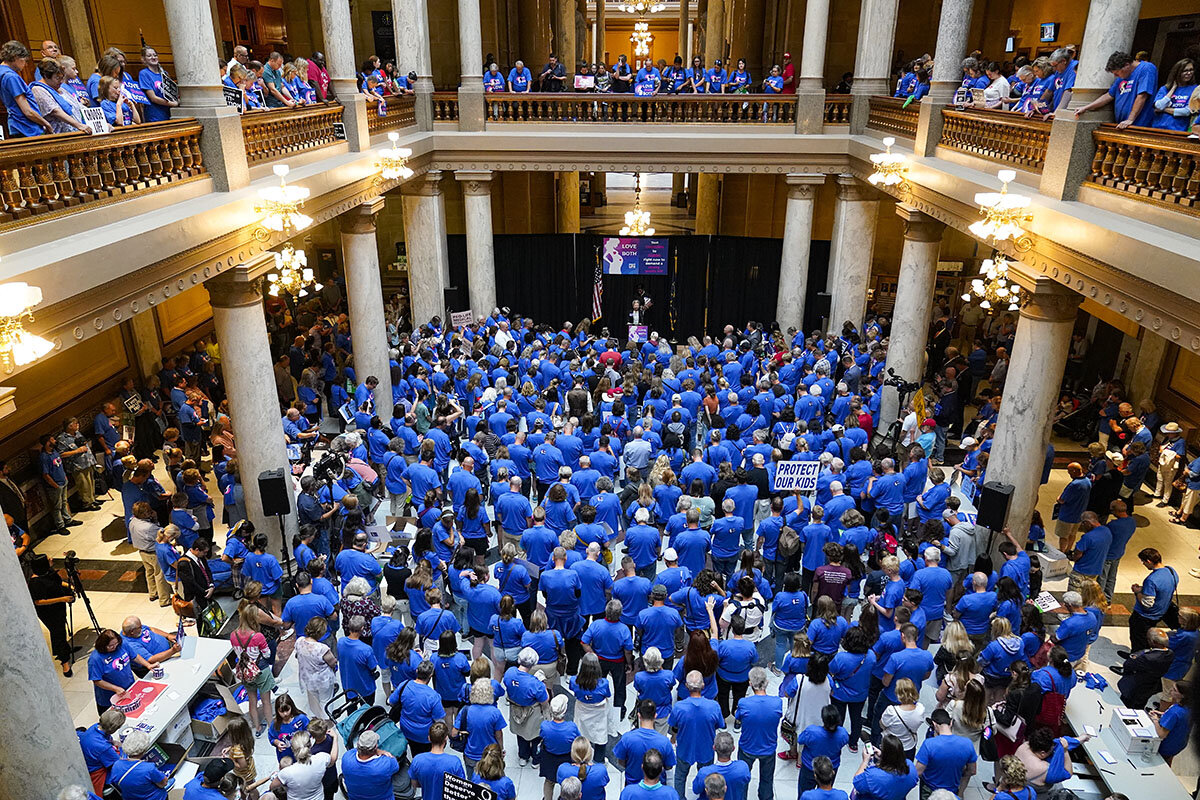Abortion politics, post-Roe, already loom over 2024
Loading...
| Washington; and Haverford, Pa.
Soha Saghir and her friend Louisa Stoll braved the cold to vote on election night in Pennsylvania, and in a quick interview, made clear why they were there: abortion rights.
Ms. Saghir and Ms. Stoll, both 2021 graduates of Haverford College, are part of the wave of young voters who helped lift Democrats to a stronger-than-expected performance in this month’s midterms. Preliminary exit poll data suggests turnout for voters under 30 approached record levels for a midterm – and abortion was their No. 1 issue. The spark was the Supreme Court’s June ruling that overturned Roe v. Wade and devolved the legal status of abortion rights to the states.
“I don’t feel super optimistic” about the future of reproductive rights on the national level, says Ms. Saghir, speaking on the Haverford campus, where she and her friend voted. But at the very least, the women agree, they can vote to support legal abortion in their state.
Why We Wrote This
Democrats campaigned on abortion rights – and it worked, helping the party beat midterm expectations. They’re likely to maintain that focus, even as the issue competes with other concerns.
In Pennsylvania, a crucial electoral battleground this cycle, Democrats defied political gravity. Despite an unpopular president, high inflation, and rising violent crime, Lt. Gov. John Fetterman captured a GOP-held U.S. Senate seat, helping Democrats lock in control of the chamber come January. Democrats also held the governor’s office, won a majority in the state House for the first time in 12 years, and saw all their congressional incumbents win.
Democrats in Pennsylvania and elsewhere were aided by weak Republican candidates, many of them backed by former President Donald Trump. Republicans did win a narrow majority in the U.S. House, and won the national vote by about 3 percentage points. But the predicted “red wave” never materialized – in part, polls suggest, because of the abortion issue.
Votes on ballot measures in California, Michigan, Vermont, Kentucky, and Montana all landed on the side of abortion rights, regardless of each state’s political lean. Those followed an August referendum in deep-red Kansas, where 59% voted in effect to keep the state’s constitutional right to abortion.
As with many political issues, the party seen as more extreme wound up getting penalized by voters. A large proportion of the public is in the middle on abortion – if the “middle” is defined as neither favoring nor opposing abortion rights in all cases, and including exceptions for rape and incest and to protect the life and health of the woman.
“If you’re out of that very large middle range, then your position is very unpopular,” says Matt Grossmann, a political scientist at Michigan State University. “That’s the risk for each party.”
Danger of overreach
In the midterms, President Joe Biden campaigned on abortion rights, calling on Congress to codify Roe. But that effort is stalled, leaving abortion access to the states for the foreseeable future. In a tacit acknowledgment of that reality, the Biden administration has pledged to ensure that women who want or need to travel across state lines to access the procedure will not be impeded.
In the new, divided Congress, both parties may try to pass bills with no chance of becoming law, just to make a point. But there’s a danger of overreach – on both sides.
“There will probably be an effort to pass some kind of national abortion ban, which is the very definition of outside the mainstream, if it includes no exceptions for rape or incest,” says Republican pollster Whit Ayres.
Republicans won control of the House because voters want them to do something about inflation, crime, and border security, Mr. Ayres says – “not to ban all abortions, or cut off aid to Ukraine, or conduct endless investigations into the Biden administration.”
GOP politicians who support abortion rights – a small universe represented most prominently by Sens. Lisa Murkowski of Alaska and Susan Collins of Maine – say Democratic legislation advertised as codifying Roe in fact goes further, and thus can’t win broad support. Bipartisan legislation in the Senate known as the Reproductive Freedom for All Act has gone nowhere.
Democratic strategists are also looking ahead. Pollster Celinda Lake predicts more statewide initiatives to enshrine abortion rights and other ways to drive the message home – both broadly and to targeted demographics.
In the 2022 midterms, more than $428 million was spent on abortion-related advertising, the vast majority by Democrats, according to the ad-tracking firm AdImpact.
More than 40% of all Democratic advertising was on the abortion issue, Ms. Lake notes, predicting “you’ll see more of that” going forward. “I think that there is now a recognition that the youth vote [is] our best vote” she adds. “Abortion and birth control can play a major role in energizing young voters, which will be important for us in 2024.”
Beyond ads, abortion-rights advocacy groups also tout the volunteer door-knocking, phone and text banking, and mail efforts that they say were vital to Democratic victories in key states, including Michigan, Pennsylvania, and Wisconsin. Those three states were the “blue wall” that Mr. Trump breached on his way to victory in 2016, and which Mr. Biden won back in 2020.
In Michigan, Democratic Gov. Gretchen Whitmer made abortion her No. 1 issue, and won reelection easily. Her party also took control of the state legislature, setting up total Democratic control of Michigan state government for the first time in nearly 40 years. The abortion-rights ballot measure spurred turnout, helping Democratic candidates, Professor Grossmann says.
Likewise, in Wisconsin, the reelection of Democratic Gov. Tony Evers and Republicans’ failure to win a veto-proof majority in the lower legislative chamber represent a victory for abortion rights.
Vice President Kamala Harris can also be counted among the midterm winners. After the Supreme Court ruling leaked in May, she held more than 35 events with abortion-rights advocates around the country, helping to rally the Democratic base. Vice President Harris was seen by some as an especially effective voice on the issue, as women of color are disproportionately affected by the demise of Roe.
Professor Grossmann inserts a note of caution. He agrees that the high court’s landmark ruling in Dobbs v. Jackson Women’s Health Organization, which overturned Roe, gave Democrats a burst of energy. But over the course of the campaign, he notes, polls showed the issue fading, with suburban women shifting back toward Republicans over the economy and crime.
“If the elections had been held in August, Democrats probably would have done even better,” Professor Grossmann says.
The next cycle
Certainly by 2024, the issue landscape will have evolved. The state of the economy matters more in presidential races than in midterms, and if high inflation and other economic challenges persist when voters go to the polls, the Democrats could face stiffer headwinds.
Some anti-abortion Republicans are also working to improve the public image of their side’s advocacy efforts. Melissa Hart, a former member of Congress from the Pittsburgh area, just joined the board of an organization called Vision for Life, which advertises the services of pregnancy care centers. Liberals often vilify such centers, saying they deceive women in crisis pregnancies to steer them away from abortion.
“People decry pro-lifers, and say they don’t care about the baby when she’s born,” Ms. Hart says. “Pregnancy care centers do everything – medical care, clothing, diapers, finding housing. A lot of people don’t know about that.”
News organizations are already starting to publish stories reflecting the real-life impact of the Dobbs ruling, and more are certain to follow. These could feature women in restrictive states trying to obtain an abortion; women who encounter roadblocks and end up having the baby; doctors navigating risky legal terrain. All could further influence the national debate.
Presidential candidates will also be pressed to take a clear stand on the issue. Mr. Trump, who has already declared his candidacy, now has Roe’s demise as part of his legacy, as he nominated the Supreme Court justices who provided the pivotal votes. But so far, he has not been trumpeting his role in overturning a nationwide right to abortion.
Florida’s GOP governor, Ron DeSantis, has also kept relatively quiet on abortion. He’s fresh off a landslide reelection and, polls show, is the top potential primary opponent to Mr. Trump, yet the issue could be tricky for him. Florida already limits abortion to 15 weeks’ gestation with no exception for rape or incest, and some state Republicans now want further restrictions. Republican supermajorities in the state legislature render Democrats powerless.
In a run for president, Governor DeSantis would need the support of a key, national Republican constituency that strongly opposes abortion to secure the GOP nomination. But if successful, he’d likely want to distance himself from hardline views to try to win the general election.
“If Ron DeSantis moves to a more extreme position, it will damage his opportunity in 2024,” says Karen Finney, a Washington-based Democratic strategist. Congress is “highly unlikely” to pass legislation that codifies Roe, she adds, which means “the spotlight will remain in the states.”







